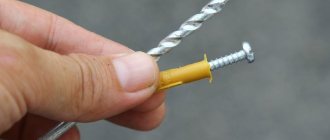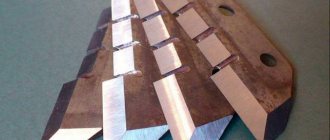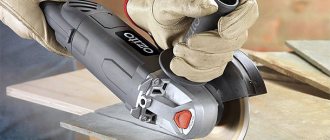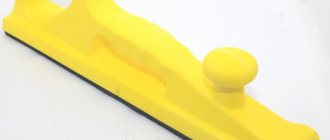Porcelain stoneware as a finishing material has gained great popularity over the past few years, which is largely due to its high strength and wear resistance. In order to process it effectively, it is necessary to use a special tool (for example, a drill for porcelain stoneware). The main difficulty in mechanical processing (including drilling) of porcelain stoneware products is that such a material, along with exceptional hardness, is also quite brittle.
For precise vertical drilling of porcelain tiles with a hand drill, you will need a diamond core bit with a centering drill, which can be supplied separately as an adapter
Design features
A wide range of drilling equipment is justified by the variety of processed materials. While plastic and wood are easy to cut, not every drill can handle a base of high density and strength. Thus, porcelain stoneware is comparable in technical indicators to natural stone. The reason is in the composition. It is made from natural granite chips. Let's look at how you can drill through porcelain tiles.
Drill
It is worth noting in advance that drills for ceramics and porcelain stoneware can be one or different tools. The fact is that ceramic tiles are often made from a clay mixture, which means they are noticeably different in strength from their counterparts made from granite chips. The material does not offer the same active resistance during processing.
Internal classification
Drills for porcelain tiles in their group differ in the working part. Feather patterns are popular among tilers. Here the tip is represented by a triangular plate pointed towards the center, inserted into the base rod. The shank is usually round in cross section, that is, suitable for the chuck of a drill or screwdriver.
Spade drill Source zubr-vrn.ru
The cutting element of the pen can be made of pobedite (tungsten-cobalt alloy) or coated steel. The main disadvantage of pobedite and diamond drills for porcelain stoneware is their short working life. The service life will be longer if you use equipment for working with less durable materials.
Another option for making a hole in porcelain stoneware is to use a ring drill. Here the working part is represented by a hollow tube, and the cutting edge is coated with artificial diamond chips. Unlike feathers, a ring tool has a service life of at least 10 times better. This tackle is capable of making about 100-150 holes in the “granite” cladding.
However, there is one drawback worth noting. It lies in the fact that the cutting part has a continuous design in a circle. For this reason, debris remains in the formed hole, which increases the pressure on the tile. This may cause unwanted cracks to appear. The solution to the problem is to work at low rotation speeds and periodically clean the treated area.
Tubular drill Source domastroy.pro
When deciding how to drill porcelain tiles on a wall or floor, you can also pay attention to ordinary drills with a Pobedit tip. This equipment is designed for concrete, so it can handle pressed stone chips. But in this case, the working life of the tool will be significantly reduced, and it cannot be restored.
Diamond crowns
Another solution to how to drill porcelain tiles so that they do not crack is to use a diamond core bit. Craftsmen classify such equipment as universal. Initially, the tool is intended for work on concrete and reinforced concrete. But it also copes well with “granite” products.
Before drilling into porcelain tiles on a floor or wall with a galvanized drill bit, there is one thing to consider. The tool can fail after just 5-6 holes.
The main advantage of diamond drilling with a core drill is the minimal risk of cracks appearing on the blade. This is due to the presence of slots on the cutting edge, through which debris is removed during the working process. That is, there is no excessive pressure on the tile.
Drilling with a diamond core Source severdv.ru
See also: Catalog of companies that specialize in the design and reconstruction of houses of any complexity
Diamond types of drills
Diamond drills for porcelain stoneware can be differentiated by type of base.
Distinctions by type of production - belonging to the diamond group:
- Galvanic finishing with diamond chips on the edges of the cutter. These drills are suitable for relatively soft rocks. This is often how drills are created in the shape of a cylinder. The disadvantage of galvanized products is their short service life. The devices fail after 5-6 holes are made. This negative side is offset by the inexpensive price, which makes it possible to buy them in multiple copies. When working with diamond crowns, you don’t need to worry too much about the enormous pressure, because it is reduced thanks to special slots at the ends of the tools.
- Sintering of diamond components onto a metal alloy sealed onto the working part of the tool. According to this production scheme, drills for long-term use are produced - annular and tubular types. Thanks to these nozzles, you can make many holes - over 100 pcs. The cutting plane of a tubular drill does not accommodate slots and appears as a complete circle. This makes it impossible to remove dust generated during the working process. At the same time, considerable pressure is exerted on the tile plane, which can cause cracks in it. Therefore, it is recommended to process tubular drills at low chuck speeds, sometimes raising the nozzle to clean the dust.
- Vacuum diffusion method of applying a diamond layer. It is used to make feathers and objects with cones. It does an excellent job of processing ultra-dense material. It is used when there is a need to drill holes d- 6, 8, 10 mm.
Additional selection criteria
It’s clear how to drill a hole in porcelain stoneware relative to the cutting element. However, this is not the only thing to consider when choosing a tool. It is also necessary to consider the required result parameters and the number of drillings performed.
Size
Before drilling porcelain tiles, precise markings are carried out. After all, here errors are sometimes unacceptable. Here, the diameter of the hole is important for choosing a drill. Manufacturers offer equipment of almost any size, but 6-12 mm in 2 mm increments are in great demand.
Pobedite drill Source cloudinary.com
The range of permissible sizes of diamond bits is noticeably wider than that of drills. It is 8-150 mm. More often, craftsmen use equipment from 20 to 100 mm. This can be explained by the parameters of pipes and boxes for utilities.
It is worth noting one point regarding the marking of drilling products. The diameter of the tooling can be specified in both mm and inches. If it is necessary to form precise holes, this fact must be taken into account.
When deciding what to drill into porcelain tiles, you can follow the recommendations of the experts. They touch small or large holes.
| Small diameter | Large diameter |
| Small sizes include seats for dowels or dowels for screws/nails. Here, the best solution would be a diamond drill for a hammer drill and ring gear. | To form holes for utility lines, only diamond core bits can be used. |
It is worth noting that tubular type equipment is subject to work with coolant (water). This rule prevents the tool from overheating due to additional friction against debris. And drills refer to drills for porcelain stoneware for dry drilling. In the case of crowns, craftsmen recommend using a centering rod for a novice worker. It is designed to adjust the position of the cylinder, eliminating unwanted sliding along the surface of the decorative canvas.
Crown with centering drill Source ozone.ru
Porcelain stoneware cutting technologies
When doing façade or interior work, it inevitably becomes necessary to cut the surface of the slab. This cannot be avoided, even recognizing that every good manufacturer has adapted elements for this or that case. You'll have to cut it. How and how to do this better, we will describe in more detail.
Dry cutting method with tile cutter
Everyone has heard about tile cutters, but many read on forums that it is impossible to halve a capricious stone with this tool. This is not entirely true. Mechanical or manual tile cutters are also different. With the right skill, everything will work out great. We are interested in a tool with a diamond roller.
The work stages will be as follows:
- We inspect the device for suitability for work. We are interested in the diamond roller, which can fail, in other words, wear out. The fastening system may become loose. If there are chips on the edge, the part must be replaced. When you turn it on and try to use it, the roller should not move. Then it is tightened or the entire fixation system is changed. Ignore it, and cutting the tiles will be impossible.
- If your tile cutter is based on bearings, then lubrication will not interfere with them, since even a slight “looseness” will lead to chips.
- Now draw a cutting line with a marker and place the roller at the beginning of the line. When inserting the tile into the device, try not to follow the line with the cutting element.
- Now you need to fix the plate with your hand, lift the handle, lower it until the roller touches the surface, but the paws remain in the air.
- Now comes the most important part. Using gentle pressure, guide the handle to the end of the tile along the marked line. It is important not to press too hard so that the surface remains without chips. It will be superfluous to pass the cutting element ten times. This way you will only achieve an unsightly cut. Once is enough.
- Now raise the foot again and lower it again, but now so that the feet touch the surface on both sides of the cut. Press down and break the material.
If the cut is rough, you can use a grinder.
Cutting with a grinder
The following method has gained the greatest popularity among the people. Buying a tile cutter for a dozen tiles is not profitable. But almost every zealous owner has a grinder. We will need a dry cutter or a special diamond disc for porcelain tiles.
The whole job consists of placing the disc in the grinder and cutting off a part from the tile. It would seem that’s it, but there are some nuances:
- Remember that you need to cut in the direction of rotation of the disk, and not vice versa. This will protect you from fragments that fly in the opposite direction from rotation. And there will be fewer chips.
- The disadvantage of this process is the mandatory formation of chips on the front side. Only skill will help minimize this. Make only one cut. Any subsequent ones will leave unsightly edges.
- Another feature of working with an angle grinder is that you need to cut not along the line itself, but 2 mm from its edge. This will leave you room to sand down the chips.
- A huge advantage of using an angle grinder is the ability to make curly lines, although it is better to practice first.
Wet cutter for tiles
What to do if you have to cut a lot and efficiently? Then an electric tile cutter will help. It is also called a wet cutter due to the peculiarities of the process, but in order.
You need to figure out what kind of wet cutter you got. They differ in the way the work is performed. One is designed so that the disk moves, the table remains stationary. On another tile cutter, the substrate moves, but the cutting element remains motionless. They may differ in the method of cooling and wetting. In one device, a container of water is installed directly under the disk. It must be said right away that the water must be changed frequently, otherwise dirt with large particles will worsen the cutting quality and shorten the service life of the disc. In another instrument, water is supplied from above.
Working with an electrical device is easier than with a mechanical one. Lay the tiles on the table, fix them on both sides with your hands. Press firmly enough to eliminate vibration, which can cause chipping. Now make the cut from start to finish without much effort.
Important! Try to avoid vibration, as the disc may jam in the material, which will lead to unpredictable consequences.
Be sure to clean the disc, because it will probably become clogged with crumbs. To do this, run it along a sand block or brick.
Each of these methods involves developing skill, up to cutting curly lines, but this is difficult to do. It is almost impossible to cut out figures, ornaments and other beautiful decorative elements at home. For this purpose, there are special machines that operate on the basis of waterjet. In production there are special high-precision milling cutters that cut porcelain stoneware surfaces like butter.
Video description
How to properly drill porcelain tiles with a diamond crown is described in the video:
Work resource
Another important criterion for determining what is better for drilling porcelain stoneware is the working resource. To form several holes, it is enough to use a Pobedit drill or drill, or a diamond-coated crown. They are relatively easy to work with and the cost is quite low.
For large-scale work or professional activities, the choice should be made in favor of tubular analogues. Here, drilling takes significantly more time, plus periodic removal of debris and cooling of the equipment. But the performance will be significant without damaging or wearing off the cutting edge.
Review of manufacturers
The quality of almost any tool depends on the manufacturer and brand. Today there are many modifications of drills for porcelain stoneware on the market, among which are products from the following companies:
Bosch. The company's products are among the highest quality on the world market. The manufacturer produces several types of drills that cope well with the tasks. Among all the variety, tubular models should be highlighted, which are distinguished by their ability to self-cool. To do this, olive oil is introduced into the structure of the material, which, when heated, is released and cools the drill.
- "Monolith". The products of the domestic company are of high quality. Products are produced using the diffusion method, which ensures high adhesion between metal and diamond chips. The use of this technology makes it possible to increase resistance to destruction several times. The diameter of the drills can reach 70 mm.
- Hawera. The company has been producing drills for a very long time. The products are characterized by increased durability and high quality. The drills are complemented by self-cooling. The products of this brand have an optimal ratio of price and technical parameters.
You can find several other manufacturers on the market, but you should understand that the quality of their materials depends only on the scope of application.
Recommendations from drilling experts
The problem often arises of how to drill a hole in porcelain stoneware for a toilet or socket yourself. The solution is to carry out work exclusively in rotational mode. That is, the best option would be to use a simple drill. The impact or impact effect will certainly lead to cracking of the “granite” coating.
Hammerless drill Source voltra.by
Another point is adjusting the number of revolutions. This is especially important when deciding how to drill porcelain stoneware on a wall/floor using ring-shaped equipment. They can only be operated at low rotation speeds.
Beginning builders often make the mistake of drilling at a deviation from a right angle. The drill must be positioned strictly perpendicular to the plane being processed. To comply with the latter, you can use a special frame-retainer for a drill or hammer drill.
Drill stand Source allegroimg.com
Making small diameter holes
To hang shelves, mirrors and other pieces of furniture, you need holes for plastic dowels or anchors. As a rule, such nests are made 6 or 8 mm in diameter. To do this, use a spear-shaped drill for ceramic tiles of the appropriate size. If the tiles are already glued, the work is carried out in two stages:
- the tile itself is drilled until the tip enters the plane of the wall;
- To obtain the required depth, a hammer drill with a drill of the appropriate diameter is used.
Before drilling the tiles, it is recommended to stick a strip of masking tape on the wall (sometimes two strips are used criss-crossed). This will reduce the risk of the drill bit slipping off the marking and will protect the edges of the hole from chipping or cracking.
Briefly about the main thing
Porcelain tiles can be drilled with a Pobedit drill using the dry method, but it will quickly fail.
More holes can be made with diamond-coated tools. If you use coolant during operation, the crowns will last even longer.
The best option is ring or tubular drills. They handle 100-150 holes. But the minus in the duration of the task is largely due to the debris accumulating at the drilling site. It constantly needs to be removed. Also, to avoid cracking of the tiles, work should be done at low speeds.
The impact mode on a rotary hammer or drill is excluded in the case of porcelain stoneware. Because of it, chips appear and the risk of cracking of the decorative material increases.
Ratings 0
Porcelain tiles on floors and walls
I personally gained special respect for porcelain stoneware when, in front of my eyes in the kitchen of my friends, a large cast-iron frying pan flew onto it... and nothing happened. Absolutely. Therefore, we also laid the floor in the living room-studio with tiles from Tintoretto’s Ceramin collection. I fell for the elegant, distressed design and expensive look at the affordable price, and my wife was delighted with how the porcelain tiles complemented the Italian history reflected in the furniture, paintings and drapes.
Later, when we were renovating the bathroom, my wife requested a design to look like natural stone, and we settled on the LASSELSBERGER Kendo collection. A similar situation: the price is more than affordable, and it looks no worse than the more “biting” Italian or Spanish samples.
You may find it useful
We had doubts about how the heavy tiles would behave on the walls, but the master was a good one, recommended buying glue that would be resistant to the tiles slipping, and did the laying expertly. Several years have already passed, everything is in place, and I am beginning to assume that this bathroom will definitely outlast us all without additional repairs.
How to drill without cracking the material?
You can avoid breaks and cracking of tiles by following several recommendations:
- Do not use an electric drill at speeds above 1000 rpm.
- If you need to drill into ceramics that have not yet been laid on the wall, soak them in a container of water for 60 minutes.
- Before you start drilling, make sure that the hammer function is turned off on the device.
- Practice on an unnecessary piece of tile to choose the optimal operating mode for the screwdriver and the pressure force.
- Do not put the unit in reverse mode.
- When drilling close to the edge, it is better to move the drill bit into the joint, otherwise it will slide off the edge of the tile.
- Start drilling at low speeds and gradually increase speed.
And finally, it is worth mentioning personal protection measures - eye and respiratory safety. During drilling, pieces of glaze and dust fly off the tiles, so do not neglect such basic means as glasses, gloves and a mask.











